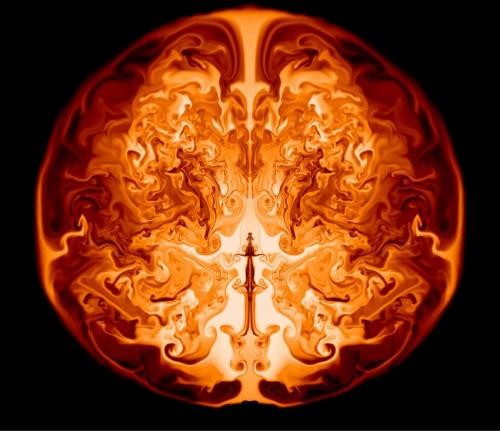Simulations Reveal Ancient Stars Die Differently
| Dino Lirios | | Oct 03, 2014 06:34 AM EDT |
(Photo : Ken Chen, University of California at Santa Cruz) It shows the inner helium core in which nuclear burning is converting helium to oxygen, powering various fluid instabilities (swirling lines). This "snapshot" from a CASTRO simulation shows one moment a day after the onset of the explosion, when the radius of the outer circle would be slightly larger than that of the orbit of the Earth around the sun.
Using simulations, scientists have mapped out the unusual death of ancient and primordial stars that give birth to more stars, and more elements.
Astrophysicists from the University of California, Santa Cruz (USCS) and the University of Minnesota ran the simulations. They worked at the Department of Energy's (DOE's) National Energy Research Scientific Computing Center (NERSC).
Like Us on Facebook
As scientists observe the deaths of stars, they noticed these deaths leave black holes in the wake of a star's destruction.
They noted, however, there were 55,000 to 56,000 stars larger than our sun that left no black holes upon their deaths. Instead, they exploded into supernovae.
Ke-Jung Chen, a postdoctoral researcher at USCS and lead author of the study, said there's a narrow window where supermassive stars explode into supernovae, not leaving any traces of black holes.
"No one has ever found this mechanism before," he added.
Without the ancient stars present to actually study, they turned to simulations to model the life of such stars. To accurately create the simulation, they used several important codes.
KEPLER is a one-dimensional stellar evolution code that takes into account key processes like nuclear burning, stellar convection, general relativistic effects, among others.
They found primordial stars could live for 1.69 million years before succumbing to instability due to general relativistic effects, thus leading to a collapse.
Upon collapse, these stars rapidly synthesize heavy elements like oxygen, neon, magnesium, silicon, and helium at its core. Through this process, the collapse is halted and the star instead explodes into a massive supernova.
Using the CASTRO code to analyze the death of the star, they reversed the explosion and saw the elements made at a star's core were being infused into the whole body of the star.
It's through this infusion of elements through the entire star that supernovas enrich the galaxy with elements and build new stars.
TagsAncient stars, primordial, Supernova, Ke-Jung Chen, KEPLER, CASTRO
©2015 Chinatopix All rights reserved. Do not reproduce without permission
EDITOR'S PICKS
-

Did the Trump administration just announce plans for a trade war with ‘hostile’ China and Russia?
-

US Senate passes Taiwan travel bill slammed by China
-

As Yan Sihong’s family grieves, here are other Chinese students who went missing abroad. Some have never been found
-

Beijing blasts Western critics who ‘smear China’ with the term sharp power
-

China Envoy Seeks to Defuse Tensions With U.S. as a Trade War Brews
-

Singapore's Deputy PM Provides Bitcoin Vote of Confidence Amid China's Blanket Bans
-

China warns investors over risks in overseas virtual currency trading
-

Chinese government most trustworthy: survey
-

Kashima Antlers On Course For Back-To-Back Titles
MOST POPULAR
LATEST NEWS
Zhou Yongkang: China's Former Security Chief Sentenced to Life in Prison

China's former Chief of the Ministry of Public Security, Zhou Yongkang, has been given a life sentence after he was found guilty of abusing his office, bribery and deliberately ... Full Article
TRENDING STORY

China Pork Prices Expected to Stabilize As The Supplies Recover

Elephone P9000 Smartphone is now on Sale on Amazon India

There's a Big Chance Cliffhangers Won't Still Be Resolved When Grey's Anatomy Season 13 Returns

Supreme Court Ruled on Samsung vs Apple Dispute for Patent Infringement

Microsoft Surface Pro 5 Rumors and Release Date: What is the Latest?










